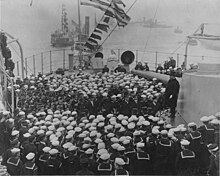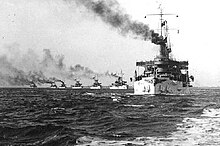Great White Fleet
The Great White Fleet was the popular nickname for the group of United States Navy battleships that completed a journey around the globe from 16 December 1907, to 22 February 1909, by order of President Theodore Roosevelt.
[3] United States President Theodore Roosevelt dispatched 16 U.S. Navy battleships of the Atlantic Fleet on a worldwide voyage of circumnavigation from 16 December 1907 to 22 February 1909.
The United States began participating in these events in 1902, when Roosevelt invited Kaiser Wilhelm II of Germany to send a squadron for a courtesy call to New York City.
[4] Additionally, the voyage of the Great White Fleet demonstrated both at home and on the world stage that the U.S. had become a major sea power in the years after its triumph in the Spanish–American War, with possessions that included Guam, the Philippines, and Puerto Rico.
[5] This was not the first demonstration of U.S. naval power; during the Algeciras Conference in 1906, which was convened to settle a diplomatic crisis between France and Germany over the fate of Morocco, Roosevelt had ordered eight battleships to maintain a presence in the Mediterranean Sea.
Pulitzer prize-winning biographer Henry Pringle states that sending Great White Fleet so dramatically to Japan in 1908 was, "the direct result of the Japanese trouble.
[10] Roosevelt saw the deployment as one that would encourage patriotism, and give the impression that he would teach Japan "a lesson in polite behavior", as historian Robert A. Hart phrased it.
While earlier capital-ship classes such as the Kearsarge, Illinois and Maine were designed primarily for coastal defense, later classes such as the Virginia and Connecticut incorporated lessons learned from the Spanish–American War and were conceived as ships with "the highest practicable speed and the greatest radius of action", in the words of the appropriation bills approved by the United States Congress for their construction.
The main sea channel of the Mare Island Naval Shipyard near San Francisco was too shallow for battleships, which left only the Puget Sound Navy Yard in Bremerton, Washington, for refit and repair.
The Hunter's Point civilian yard in San Francisco could accommodate capital ships, but had been closed due to lack of use and was slated for demolition.
However, the United States did not enjoy a worldwide network of coaling stations like that of Great Britain, nor did it have an adequate supply of auxiliary vessels for resupply.
During the Spanish–American War, this lack had forced Admiral George Dewey to buy a collier-load of British coal in Hong Kong before the Battle of Manila Bay to ensure his squadron would not run out of steam at sea.
The need had been even more pressing for the Russian Baltic Fleet during its long deployment during the Russo-Japanese War, not just for the distance it was to steam, but also because, as a belligerent nation in wartime, most neutral ports were closed to it due to international law.
While the lack of support vessels was pointed out and a vigorous program of building such ships suggested by Rear Admiral George W. Melville, who had served as chief of the Bureau of Equipment, his words were not heeded adequately until World War II.
Roosevelt initially offered to award Navy supply contracts to American skippers whose bids exceeded those of foreign captains by less than 50%.
[21] Unlike the formidable obstacles that had faced the Russian fleet[nb 1] on its voyage from the Baltic to the Pacific, which eventually led to its destruction by the Japanese in 1905,[22][23] the U.S. effort benefited from a peaceful environment, which aided the coordination of ship movements.
The two oldest ships in the fleet, Kearsarge and Kentucky, were already obsolete and unfit for battle; two others, Maine and Alabama, had to be detached at San Francisco because of mechanical troubles and were replaced by the Nebraska and the Wisconsin.
After repairs, Alabama and Maine completed their "own, more direct, circumnavigation of the globe" via Honolulu, Guam, Manila, Singapore, Colombo, Suez, Naples, Gibraltar, the Azores, and finally back to the United States, arriving on 20 October 1908, four months before the remainder of the fleet, which had taken a more circuitous route.
[31] With Connecticut[33] as flagship under the command of Rear Admiral Robley D. Evans, the fleet sailed from Hampton Roads on 16 December 1907 for Trinidad, British West Indies, thence to Rio de Janeiro, Brazil; Punta Arenas, Chile; Callao, Peru; Magdalena Bay, Mexico, and north along the West Coast, arriving at San Francisco on 6 May 1908.
Leaving that port on 7 July 1908 the U.S. Atlantic Fleet visited Honolulu; Auckland, New Zealand; Sydney, Melbourne, and Albany, Australia; Manila, Philippines; Yokohama, Japan; and Colombo, Ceylon; then arriving at Suez, Egypt, on 3 January 1909.
While the fleet was in Egypt, word was received of an earthquake in Sicily, thus affording an opportunity for the United States to show its friendship to Italy by offering aid to its victims.
[28] Leaving Messina on 9 January 1909, the fleet stopped at Naples, Italy,[citation needed] thence to Gibraltar, arriving at Hampton Roads on 22 February 1909.
[35] The cruise of the Great White Fleet provided practical experience for US naval personnel in sea duty and ship handling.
The lack of American logistical support was also laid bare, ramming home the lesson that without an adequate homegrown merchant marine, control of the seas was all but impossible....It demonstrated America's ability to transfer power from the Atlantic Ocean to the Pacific.
[39] The Times of London editorialized regarding the extremely enthusiastic reception in Australia: "A spectacular display has valuable uses in impressing the masses, who will remember the sight for years, and draw important political deductions therefrom.
For instance, in terms of seaworthiness, all the capital ships in the fleet proved wet in all but the calmest seas, which led to the flared bows of subsequent U.S. battleships, increased freeboard forward and such spray-reducing measures as the elimination of billboards for anchors and gun sponsons.
Another discovery was that, even when fully loaded, the bottom of the battleships' side armor was visible—and the ships thus vulnerable to shells that might hit beneath it to reach their machinery and magazines—in smooth to moderate seas.
Before the cruise, critics such as then-Captain William Sims (to whom President Roosevelt listened) had argued that American warship design had remained too conservative and precluded the level of efficiency needed for the fleet to function as an effective unit.
When President Roosevelt convened the 1908 Newport Conference of the Naval War College, he placed responsibility for U.S. battleship design on the General Board of the United States Navy.
This gave line officers and planners direct input and control over warship design, a pattern which has persisted to the present day.















